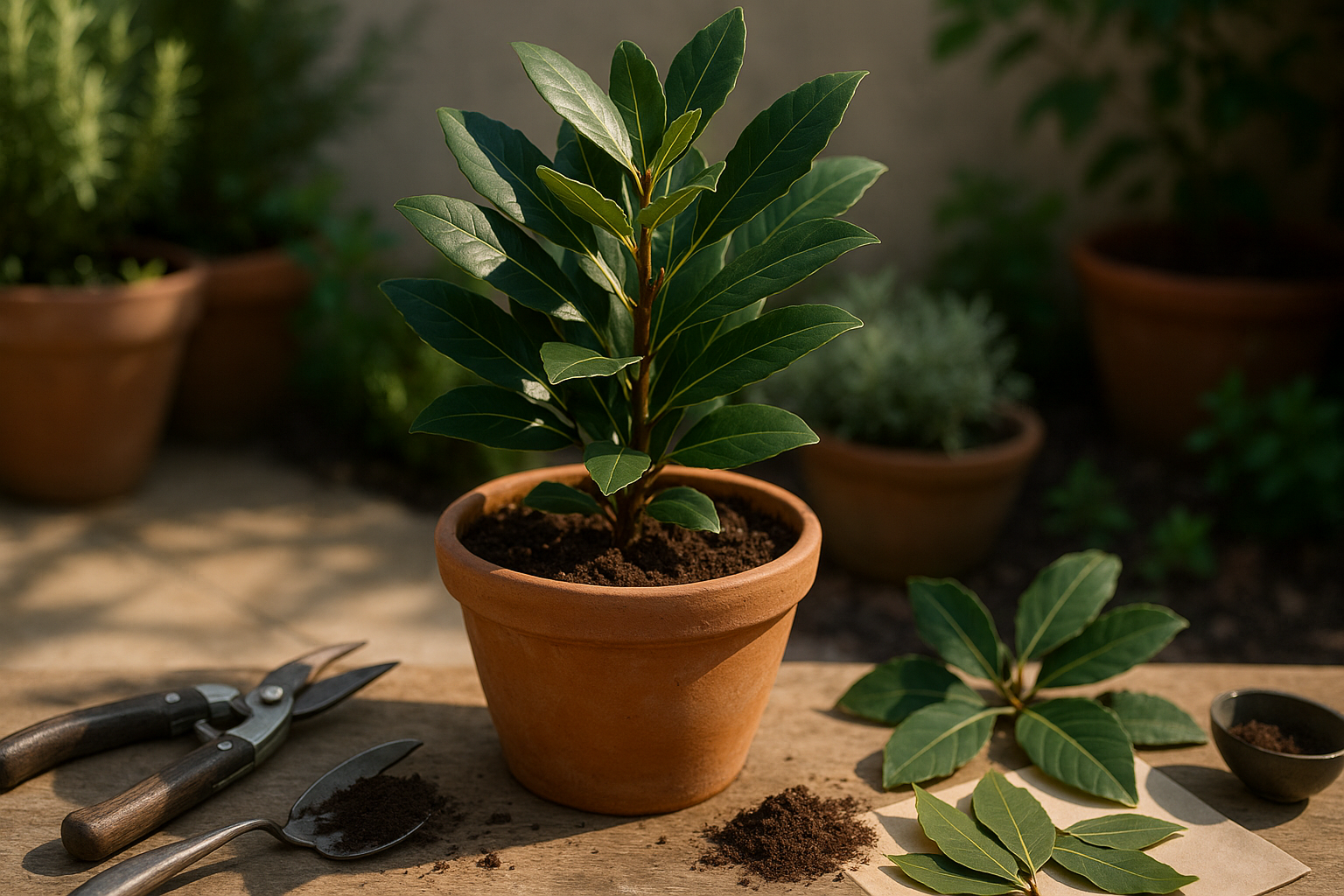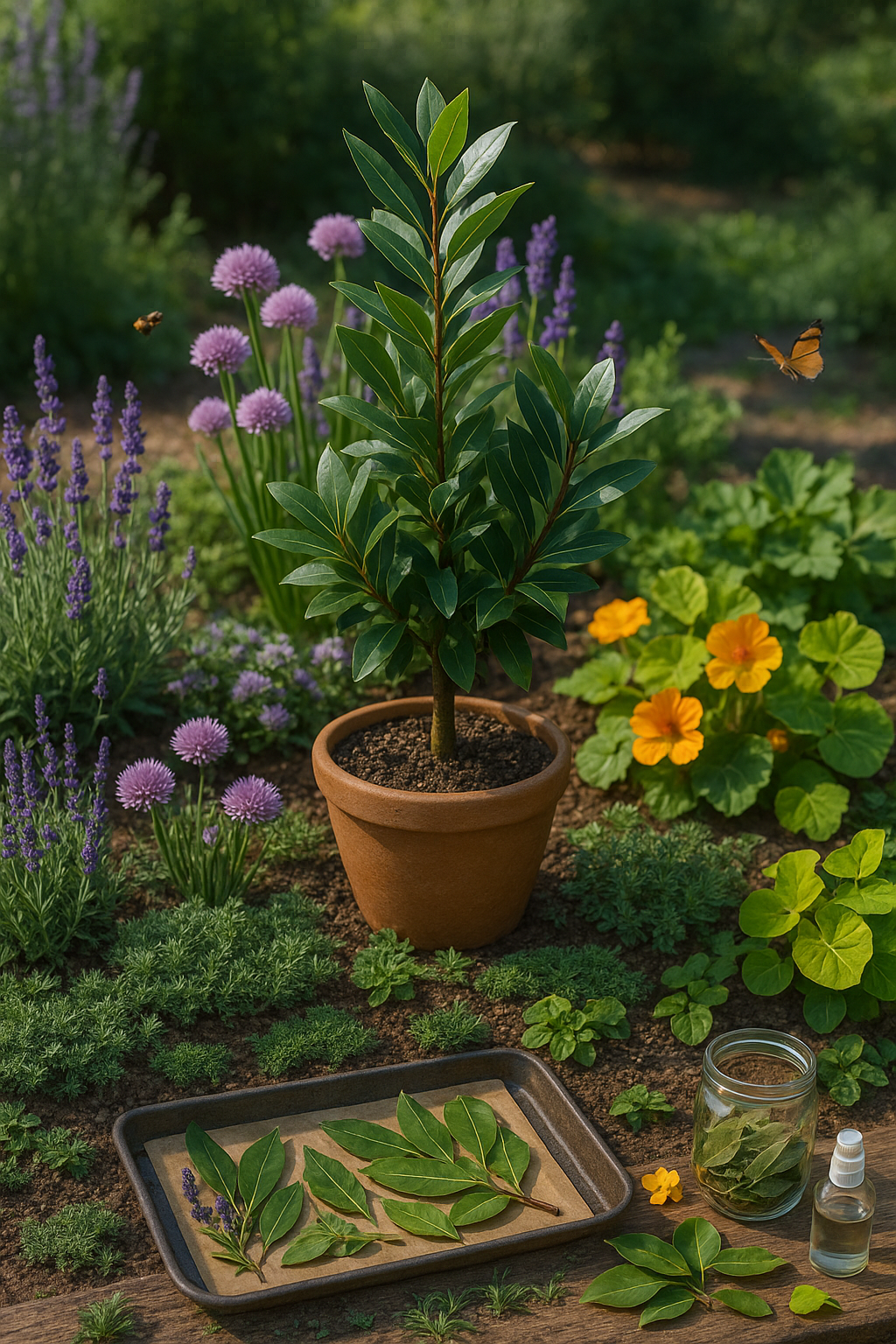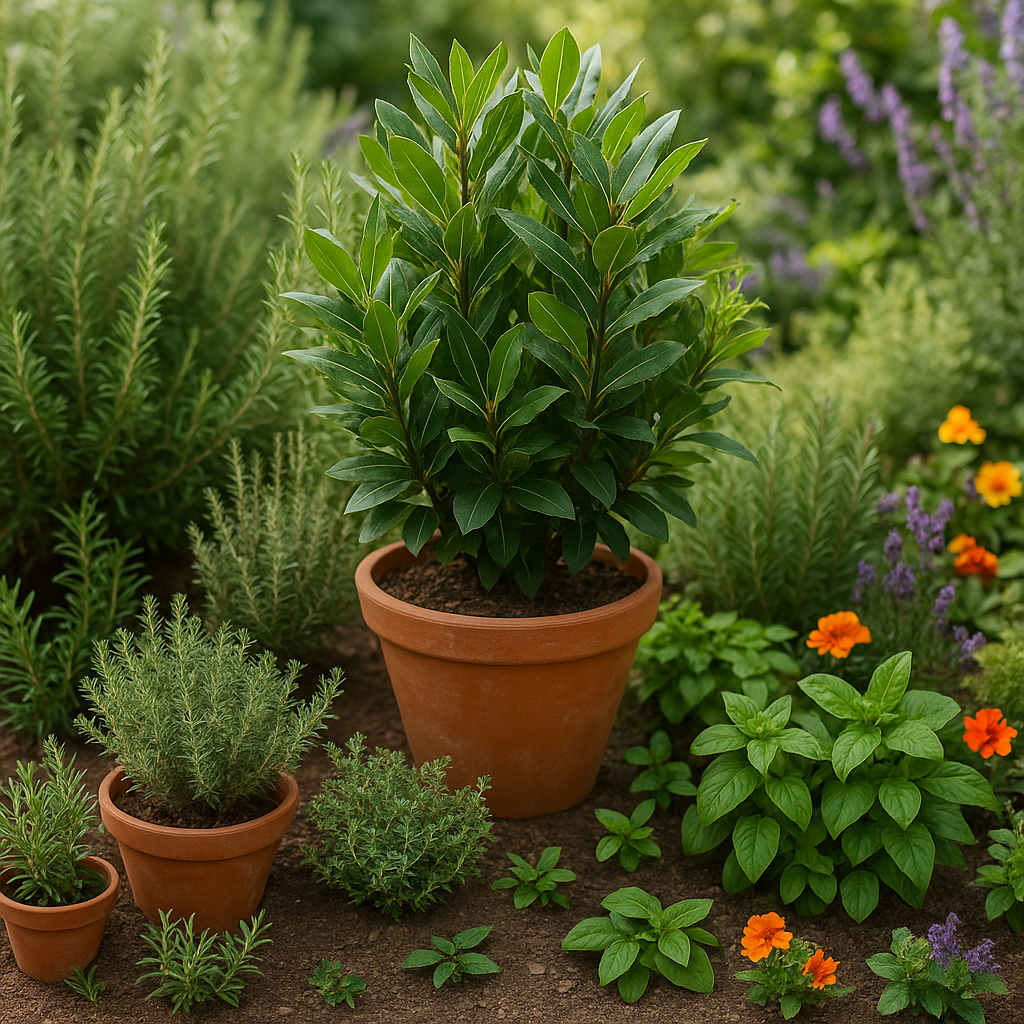Bay Leaf: The Hardy Evergreen Herb

Bay leaf, also known as bay laurel (Laurus nobilis), is a hardy, evergreen shrub native to the Mediterranean. Renowned for its fragrant, glossy dark-green leaves, bay laurel is a favorite both in kitchens and ornamental gardens. This aromatic herb thrives in full sun to partial shade and prefers well-draining soil that’s kept moist but not soggy.
Bay laurel can grow as a bushy shrub or be shaped into a small tree, reaching heights of 10 to 30 feet outdoors, but it remains manageable when grown in containers.
Companion Planting with Bay Laurel
Companion planting—an age-old gardening practice—involves grouping plants together to encourage natural growth, prevent pests, and maximize yield. By pairing plants with complementary characteristics, gardeners can foster healthier gardens without relying on chemicals.
For instance, strong-scented herbs like bay laurel can deter some insect pests from more vulnerable neighbors. Bay’s dense growth habit and aromatic oils work as a mild natural pest repellent, making it useful for planting near carrots, beans, or tomatoes to discourage insects and promote a balanced garden ecosystem.
Planting Tips and Considerations
- Bay laurel’s tendency to cast shade and compete for nutrients with shallow-rooted plants means it’s best suited as a backdrop or potted companion.
- Avoid mixing it directly with delicate annuals.
- Keeping bay in containers makes it easy to reposition for optimal sunlight and airflow.
- Containers also allow you to bring bay indoors during cold winters.
By leveraging bay laurel’s unique properties within companion planting, home gardeners can create a thriving, resilient, and flavorful outdoor space.
Bay Leaf Companion Planting
Bay leaf thrives alongside a variety of aromatic herbs, making it a great choice for companion planting in your herbal garden. Rosemary and thyme are excellent partners, both enjoying sunny locations and well-drained soil, just like bay laurel. These Mediterranean natives appreciate infrequent but deep watering, which helps prevent diseases caused by soggy roots.
Sage, oregano, marjoram, and basil are also compatible, sharing similar sunlight and soil preferences, making maintenance simpler for gardeners. Planting these fragrant herbs together does more than just simplify care—they can actually boost each other’s health.
Herbs like rosemary and thyme naturally repel pests such as aphids and spider mites, which might otherwise target tender bay leaves. Oregano and marjoram attract beneficial pollinators that help your whole garden thrive, while basil’s strong scent helps mask vulnerable plants from hungry insects.
For the best results, leave enough space between each plant to allow for good air circulation and prevent mold or mildew. Regular pruning not only keeps bay trees and their companions in check but also stimulates the production of essential oils, intensifying their aroma and flavor.
Try grouping herbs based on their culinary uses—pair bay, rosemary, and thyme for savory stews, or basil and oregano for Italian-inspired blends—so you can snip a perfectly balanced handful fresh for your recipes. This not only enhances synergy in the garden but brings even more depth to your cooking, all while providing a healthy, pest-resistant environment for your bay leaf plants to flourish.
When Designing a Vibrant Garden Bed Around Your Bay Leaf Plant

Consider adding ornamental and sensory companions like lavender, chives, and edible flowers such as marigold and nasturtium. Lavender offers a wonderful fragrance and spikes of purple that beautifully contrast with the deep green of bay leaves. It also attracts bees and butterflies, essential for pollination.
Chives bring their own subtle aroma and cheerful purple blossoms, making them an attractive border plant. Their onion scent helps deter aphids and other pests that might bother nearby greenery.
Edible flowers like marigolds and nasturtiums provide dual benefits—they brighten your garden with bold colors and act as powerful allies against unwanted bugs. Marigolds, with their sunny blooms, naturally repel nematodes and some beetles, while nasturtiums serve as a trap crop, luring aphids away from valuable herbs.
Plus, both flowers are edible and can be tossed into salads for a pop of color and a peppery or citrus flavor, making your harvest both beautiful and useful. By selecting these ornamental and sensory plants, you create a visually striking, fragrant, and productive space that supports pollinator health, keeps harmful pests at bay, and adds a touch of joy to every garden stroll.
Ground Covers for Bay Leaf Trees
Ground covers such as creeping rosemary, thyme, and sweet alyssum are wonderful living mulch options to plant around your bay leaf trees. These hardy, low-growing plants serve multiple purposes in the garden—they blanket the soil to block sunlight, helping suppress weeds and reducing constant weeding sessions.
By covering exposed ground, they also help retain soil moisture, so your bay leaf and neighboring plants experience less stress during hot spells. Some, like thyme and rosemary, release aromatic oils that naturally repel certain pests, offering your bay leaf a bit of added protection.
Meanwhile, incorporating flowering ground covers like sweet alyssum attracts pollinators and beneficial insects, which is vital for a healthy, balanced garden.
Boosting Pollinator Visits
To further enhance pollinator visits, consider planting nearby native species such as:
- Coneflowers
- Yarrow
- Lavender
- Milkweed
Or include herbs like basil and dill, which flower beautifully and attract bees and butterflies. These additions invite a steady stream of pollinators and predatory insects like ladybugs, which help keep harmful garden pests in check.
By mixing ground covers and pollinator-friendly flowers, you create a living, self-supporting community around your bay leaf plants that looks lush, stays healthier, and requires less ongoing maintenance.
For gardeners looking to cultivate a peaceful haven, less-common companion plants like chamomile and lemon balm are unsung heroes.
Not only do they infuse the air with soothing scents, but their lush green foliage and petite flowers attract pollinators while calming both the garden and the gardener. Plant chamomile between rows of vegetables to suppress weeds and attract pest-fighting beneficial insects, or tuck lemon balm near walking paths so its fresh citrus fragrance is released every time you brush past.
To create a truly immersive experience, design fragrance pathways that wind visitors past clusters of scented herbs. For example, plant a border of bay leaf, whose deep, woody aroma pairs naturally with beds of rosemary, thyme, or oregano—perfect for a Mediterranean-inspired cooking theme.
Additionally, lining vegetable beds with bay leaf not only adds structure and evergreen beauty through the seasons, but it can also act as a natural pest deterrent. Try grouping bay leaf with edible borders made from chives, nasturtiums, or calendula: these combinations elevate the look of your garden while offering handy ingredients for the kitchen.
Think of a salad bowl border, where bay leaves mingle with bursts of nasturtium flowers and the gentle hum of bees lingers as you harvest. By blending calming companions and creative edible pairings, your garden becomes both a sensory retreat and a space that brings beauty and bounty to the dinner table.
When planning your garden, it’s important to know that certain plants can actually hinder the growth of bay leaf (Laurus nobilis).
Members of the Brassica family—cabbage, broccoli, cauliflower, and kale—aren’t good neighbors for bay leaf since they have conflicting water and nutrient needs. Brassicas prefer consistently moist soil, while bay leaf thrives best with less frequent watering, which can create an imbalance for both.
Root crops like onions, garlic, and potatoes may also compete heavily for space and nutrients below the soil, possibly stunting your bay leaf’s growth. Some plants, like fennel, release allelopathic chemicals into the soil that can inhibit bay leaf root development.
Additionally, planting bay leaf near pest-attracting crops (such as tomatoes or beans) can lead to a higher risk of infestation, since pests may be more inclined to attack your herbs as well.
To avoid these issues, always leave plenty of space around your bay leaf tree, ideally positioning it away from large, fast-growing vegetables or those with aggressive roots. Raised beds or separate containers work great for managing crowding and preventing the underground competition that slows bay leaf growth.
Careful placement ensures your bay leaf plant will stay healthy and flourish.
Cultivating Harmony in Your Bay Leaf Garden
Cultivating harmony in your bay leaf garden starts with smart companion planting—pairing your bay tree with compatible herbs and flowers like oregano, sage, or marigolds can enhance growth and naturally deter pests. Give your bay laurel plenty of space so its aromatic leaves have good airflow, and pay attention to light: full sun to partial shade works best.
Keep the soil evenly moist, watering deeply but allowing the top inch to dry out between sessions. Use mulch to help retain moisture and suppress weeds. Prune your bay tree regularly to encourage bushier growth and remove any damaged or diseased branches.
For pest management, check leaves for signs of scale insects or aphids, and use a gentle soap spray if needed. Don’t be afraid to experiment—observe how different plant combinations work in your garden, and adjust as you go to see what thrives together.
Every garden is unique, so keep notes on what’s successful. This helps you create an environment where bay and its companions grow in harmony season after season.
